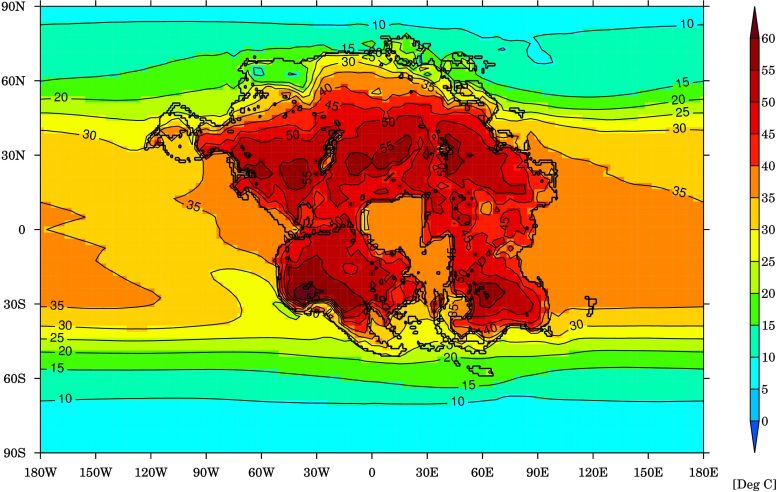
A pioneering study warns of an impending mass extinction event due to unprecedented global heat, which could endanger nearly all mammals in about 250 million years.
A study predicts a mass extinction of mammals in 250 million years due to extreme heat from the formation of a supercontinent. The research highlights the lethal combination of a hotter sun, increased CO2, and continental effects, underscoring the importance of landmass layouts in evaluating the habitability of exoplanets.
Unprecedented heat is likely to lead to the next mass extinction since the dinosaurs died out, eliminating nearly all mammals in some 250 million years’ time, according to a new study.
The research, published on September 25 in the journal Nature Geoscience and led by the University of Bristol, presents the first-ever supercomputer climate models of the distant future and demonstrates how climate extremes will dramatically intensify when the world’s continents eventually merge to form one hot, dry and largely uninhabitable supercontinent.

The image shows the geography of today’s Earth and the projected geography of Earth in 250 million years, when all the continents converge into one supercontinent (Pangea Ultima). Credit: University of Bristol
Factors Contributing to Extreme Temperatures
The findings project how these high temperatures are set to further increase, as the sun becomes brighter, emitting more energy and warming the Earth. Tectonic processes, occurring in the Earth’s crust and resulting in supercontinent formation would also lead to more frequent volcanic eruptions which produce huge releases of carbon dioxide into the atmosphere, further warming the planet.
Mammals, including humans, have survived historically thanks to their ability to adjust to weather extremes, especially through adaptations such as fur and hibernating in the cold, as well as short spells of warm weather hibernation.
While mammals have evolved to lower their cold temperature survivable limit, their upper-temperature tolerance has generally remained constant. This makes exposure to prolonged excessive heat much harder to overcome and the climate simulations, if realized, would ultimately prove unsurvivable.

Image shows the warmest month average temperature (degrees Celsius) for Earth and the projected supercontinent (Pangea Ultima) in 250 million years, when it would be difficult for almost any mammals to survive. Credit: University of Bristol
Implications for Mammals
Lead author Dr. Alexander Farnsworth, Senior Research Associate at the University of Bristol, said: “The newly-emerged supercontinent would effectively create a triple whammy, comprising the continentality effect, hotter sun and more CO2 in the atmosphere, of increasing heat for much of the planet. The result is a mostly hostile environment devoid of food and water sources for mammals.
“Widespread temperatures of between 40 to 50 degrees Celsius, and even greater daily extremes, compounded by high levels of humidity would ultimately seal our fate. Humans – along with many other species – would expire due to their inability to shed this heat through sweat, cooling their bodies.”
Although human-induced climate change and global warming is likely to be a growing cause of heat stress and mortality in some regions, research suggests the planet should largely remain habitable until this seismic landmass change in the deep future. But when the supercontinent forms, findings indicate only somewhere between 8% and 16% of land would be habitable for mammals.
Addressing Current Climate Crisis
Co-author Dr. Eunice Lo, Research Fellow in Climate Change and Health at the University of Bristol said: “It is vitally important not to lose sight of our current Climate Crisis, which is a result of human emissions of greenhouse gases. While we are predicting an uninhabitable planet in 250 million years, today we are already experiencing extreme heat that is detrimental to human health. This is why it is crucial to reach net-zero emissions as soon as possible.”
Methodology and Future Predictions
The international team of scientists applied climate models, simulating temperature, wind, rain, and humidity trends for the next supercontinent – called Pangea Ultima – expected to form in the next 250 million years. To estimate the future level of CO2 the team used models of tectonic plate movement, ocean chemistry, and biology to map out inputs and outputs of CO2.
The future CO2 calculations were led by Professor Benjamin Mills at the University of Leeds, who said: “We think CO2 could rise from around 400 parts per million (ppm) today to more than 600 ppm many millions of years in the future. Of course, this assumes that humans will stop burning fossil fuels, otherwise, we will see those numbers much, much sooner.”
Dr. Farnsworth, also a visiting Professor at the Tibetan Plateau Earth System, Environment and Resources (TPESER), at the Chinese Academy of Sciences Institute of Tibetan Plateau Research said: “The outlook in the distant future appears very bleak. Carbon dioxide levels could be double current levels. With the Sun also anticipated to emit about 2.5% more radiation and the supercontinent being located primarily in the hot, humid tropics, much of the planet could be facing temperatures of between 40 to 70 °C.
“This work also highlights that a world within the so-called ‘habitable zone’ of a solar system may not be the most hospitable for humans depending on whether the continents are dispersed, as we have today, or in one large supercontinent.”
Relevance to Exoplanet Research
In addition, the research illustrates the importance of tectonics and continental layouts when conducting research into planets beyond our solar system, called exoplanets. Although the Earth will still be within the habitable zone in 250 million years’ time, for mammals the formation of a supercontinent with elevated carbon dioxide will make most of the world uninhabitable. The findings suggest the landmass layout for a distant world could be a key factor when determining how liveable it is for humans.
Reference: “Climate extremes likely to drive land mammal extinction during next supercontinent assembly” by Alexander Farnsworth, Y. T. Eunice Lo, Paul J. Valdes, Jonathan R. Buzan, Benjamin J. W. Mills, Andrew S. Merdith, Christopher R. Scotese and Hannah R. Wakeford, 25 September 2023, Nature Geoscience.
DOI: 10.1038/s41561-023-01259-3
The research formed part of a funded project, funded by the UK Research and Innovation Natural Environment Research Council (UKRI NERC) looking at the climates of supercontinents and mass extinctions.









What a completely irrelevant thought experiment and it’s more than a little embarrassing that they’ve published it. (well, I suppose stereotypical British scientists do exists)
Happens every 100 thousand years, it’s part of the Ice Age Cycle.
If anyone has any DOUBT as to the utter alarmism spooned out by Google and other ‘big tech’ companies, all they need consider is that THIS ridiculous tripe is picked up on DAY ONE of its posting and added to my “news” feed. (And no, it’s not because the algorithm is matching it to me because this is the kind of nonsense I enjoy.)
“Oh, no! Only 250 MILLION years left? I had better give ALL MY MONEY to the government RIGHT AWAY, so they can get to work on fixing the problem. You know, despite their evident propensity for spending endless amounts of money they don’t have to accomplish NOTHING.”
Kee-bloody-ripes.
Junk Science, Please Dis-Regard.
Oh.My.God….could this be any more inane???? Yeah, it convinced me to put SciTechDaily on my Google News BLOCKED list!!!
My mother-in-law read this “Episal Bristol” and wants the family to move to
Northern Alaska. I informed the post office that she has a new address. The
rest of the family is willing to wait. Thank you for the article. It is
quiet around here now.
250 Million Years? By 2030 there won’t be a single human being standing on Earth. This articles displays the writer’s complete ignorance of the true state of the climate emergency. Temperatures already reach wet bulb conditions in many parts of the world in 2023. 2024 will be much worse and severe food shortages will occur. Climate change is now abrupt, exponential, and irreversible. Humanity is in deep trouble right now. Climate change makes species extinct by rendering habitat uninhabitable. We are quickly approaching that point. Multiple tipping points have been breached and are combining exponentially to end life on Earth.
Exaggerate much? It reads like sarcasm, but I’m afraid you are serious. We went almost 9 years without any statistically significant warming until the most recent El Nino this Spring. We’ll probably have a year or two of above average temperatures, and then it will drop back down. There is NO way that the Earth will be uninhabitable by humans in seven years, short of a nuclear war.
Total BS piece.
This is fantastic and timely news. Disregard the nay sayers here a bouts as they say nay anywhere and as much as they can. And so many o’ them think they are going to be around forever and ever and ever again so 250 million years ain’t so long a slog.They should appreciate the heads up and do with the valuable information as they see fit.
“… so 250 million years ain’t so long a slog.”
It is about half the time that complex multicellular life has been present on Earth. It is about the time since the End Permian Great Dying, when dinosaurs first evolved, and 4X as long as when dinosaurs became extinct.
Agree that this is pure nonsense with respect to the current “crisis” where after 140 years of adding CO2 to improve our lives the global average temperature is up by only plus 0.84°C. A climate emergency???
It’s just the obvious facts thatre stated here in this essential article. Humans think they own and control the earth and that’s childish.you should watch beatchs to see how hot things are ge⁸tting around heeer in thißss earth
Extinction? No. Move to higher elevations? Yes. The formation of a supercontinent should also create some nice, high mountains… where it will be cooler, and Sherpas will take over the planet. Current global warming is already seeing plants and animals move to higher elevations.
Not just higher elevations. Moving to higher latitudes will result in cooler climates as well.
Warm-blooded mammals probably have a better chance of survival than reptiles and amphibians. Extinction cycles have historically been about 27 million years in length.
https://scitechdaily.com/researchers-discover-that-global-mass-extinctions-of-land-dwelling-animals-follow-a-27-million-year-cycle/
Considering that humanoids have only been around for about 10% of that time, it is unlikely that humans, as we know them, will last for more than a fraction of the 250 million-year deadline.
This whole article is so absurd that I have to speculate that the author has just experienced a bad LSD trip. However, it is irresponsible to scare the readership with prognostications about a future that is half as long as complex, multi-cellular life forms have existed, and blame it on fossil fuels that will likely be exhausted in about a century. This is a new low in ‘science!’
This a fricking joke. Send the authoir back to get their degree in English, because this is just fantasy.
Although not worth commenting on, I am happy to see that other readers agree that this is silly stuff. 250 million years, and a supercontinent? Either our curreent crisis (s) or technology (including moving off earth) renders such a long forecast irrelevant,
Ya, Google, and SciTechDaily, keep it.
There might be one redeeming factor in that they mentioned 40oC, due to CO2, will kill mammals, Including humans. We will surly be hitting 50oC before 2050, perhaps before 2030.
As a human living in the climate criminal Province of Alberta, I want to apologise – sorry for the mass extinction of humans. The greed of oil and corporate culture is the cause of CO2, so that is where we must apply pressure.
Would you like some more Kool-Aid?
It is unlikely that the Earth will be more than 0.2 deg C warmer by 2030, under the worst circumstances.
elk moving down to my backyard nice to see them there
not so much in the mountains i guess. and down by
lower chana river actually in hot times
250 million years is a very long time. interesting work, If the human race is to be there we must support our intelligence will become that of enabling our performance to travel thru space at will. The image shows destruction not ability, what is our pace of ability to the ultimate change in our home planet.
How has scitechdaily.com become a gathering place for science-denying right-wingers with subterranean IQ and education levels? Have Fox News, Alex Jones, etc. been telling them to go troll mainstream media as part of their race-to-the-bottom strategy? Very strange. At the same time, these experts are lapping up their cult leader’s inane stories about whales being killed in large number by wind turbines, which he calls windmills.
Are you suggesting that there is any science in this article that needs denying?
Old news: As the Sun progressively gets hotter (1 degree Celsius per thousands years), it will eventually evaporate all water on earth. That is expected to occur in about 500 million years. This means humans and most living things would disappear millions (if not tens of millions) of years before that – unless, of course, the progress of science and technology allows us to escape the planet for greener pastures.
What this new research adds to the picture is the movement of the continental tectonic plates, which will again converge to form a single continent out of the several we have now and shorten the period between now and the total extinction of life on earth.
While there have been super-continents more than once in the past, there is no way that I’m aware of to reliably predict when, where, or IF it will happen again. This is little more than fantastical speculation, probably better referred to as the fiction genre ‘science fantasy.’
There are so many things you’re not aware of it’s not funny.
You haven’t provided any information that would lead me to believe you are in possession of more knowledge than me. How about telling the readership just how you would predict where a supercontinent might form, and how large it would be, and what you would base that prediction on?
So we’ll all die in the future? No sh*t Sherlock.
It takes an ignoramus to jump to wrong conclusions – probably the only exercise they get.
Your insults aren’t contributing to anyone learning anything from you.
250 million years from now we will have a problem? Even if that prediction is 100% true, it lacks insight. What will 1 million years of scientific advancement offer us in solutions? Nobody knows, and this article is specious paranoia more worthy of the tabloids than a serious scientific consideration.
“What will 1 million years of scientific advancement offer us in solutions?”
The answer to this question is contained in the general scientific knowledge of most educated people today. It’s also contained in my first post on this subject. You just dug your ilk’s grave a little more deeply by confirming your ignorance and serious reading comprehension issues.
Word salad without substance.
Anything you don’t understand is a “word salad”? I gave you a solid clue where you can find the solution I mentioned – my initial comment (something that even your hero, right-winger Elon Musk, believes in). A wise man had you number when he said that the difference between intelligence and foolishness is that intelligence has its limits.
When you start accusing a stranger, whom you know nothing about, of having heroes of any stripe, you are demonstrating that you are tinfoil-hat material.
“Tectonic processes, occurring in the Earth’s crust and resulting in supercontinent formation would also lead to more frequent volcanic eruptions which produce huge releases of carbon dioxide into the atmosphere, further warming the planet.”
However, empirical evidence, such as from the Oligocene, suggest that global cooling is equally likely, particularly from the effusive mountain building episodes associated with colliding plates. The interior of any such supercontinent would most likely be more like the Sahara Desert, with low humidity, and depending on where the plates coalesce, might be much cooler. These ‘experts’ are good evidence that our modern educational system is failing society, and the scientific journals are doing a poor job of ‘gate keeping.’
Are we serious? What a waste of time and money, please tell me this was not tax payer supported? How many other factors that haven’t been thought of are going to affect the outcome? This paper is flat out a piece of trash and doesn’t deserve to be printed!! Hell, the Sun will probably go Supernova before then! lol. STOP the garbage please?
“… funded by the UK Research and Innovation Natural Environment Research Council”
Several million years ago the inhabitants of Mars rendered their planet uninhabitable by constant war and pollution. They moved to planet earth, so I guess they never learned their lesson because these distant relatives are doing the same things over again
A lot of adaptive evolution can happen in 250 million years and continents don’t move that quickly. However, we had better work out which bits of the planned supercontinent might be survivable and in the meantime have a few wars so that we can plant our national flags on those bits. Or I rather suspect H sapiens will be happily extinct by then. However, we could try to warn the next hominid that chooses to fall out of its tree and start walking upright on its two legs. We could leave a warning plaque on either the Moon or Mars, both of which seem to free from severe weathering.
2 Peter 3:10 NASB1995
But the day of the Lord will come like a thief, in which the heavens will pass away with a roar and the elements will be destroyed with intense heat, and the earth and its works will be burned up.
Yep it’s gonna get hot. Get right so you’re not hot too.
“It is vitally important not to lose sight of our current Climate Crisis, which is a result of human emissions of greenhouse gases. While we are predicting an uninhabitable planet in 250 million years, today we are already experiencing extreme heat that is detrimental to human health. This is why it is crucial to reach net-zero emissions as soon as possible.”
The authors aren’t clear on what the focus of the article is. Is this report on research about modeling future tectonic plate motion, or is that just click bait for the daily sermon about the evil of human use of fossil fuels? Maybe the modeling claim was so far out in left field that they felt the only way they could get it published was to throw in concerns about modern warming? If they had also included something about their favorite apple pie recipes they could have added at least a couple more authors to the list. I don’t understand how something this poorly written made it through peer review.